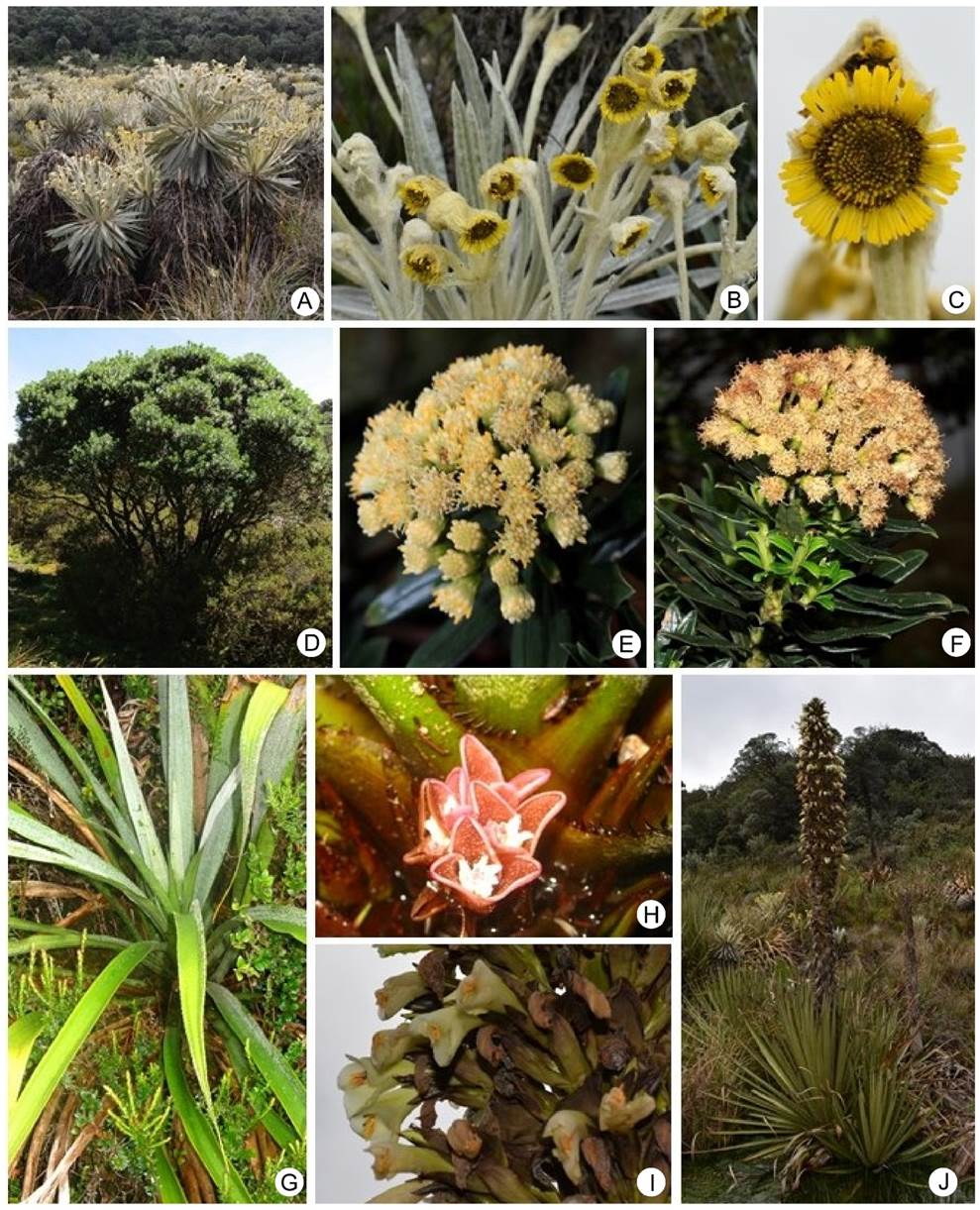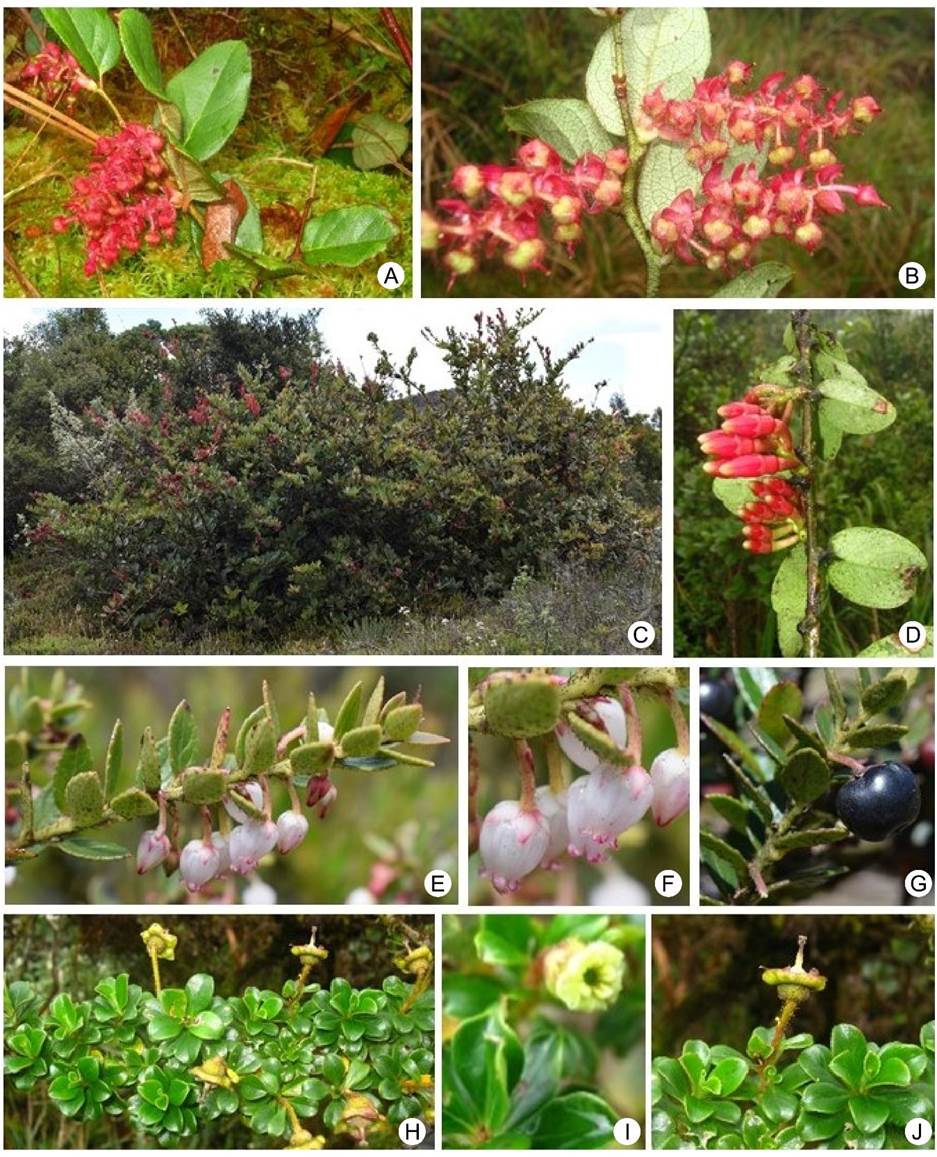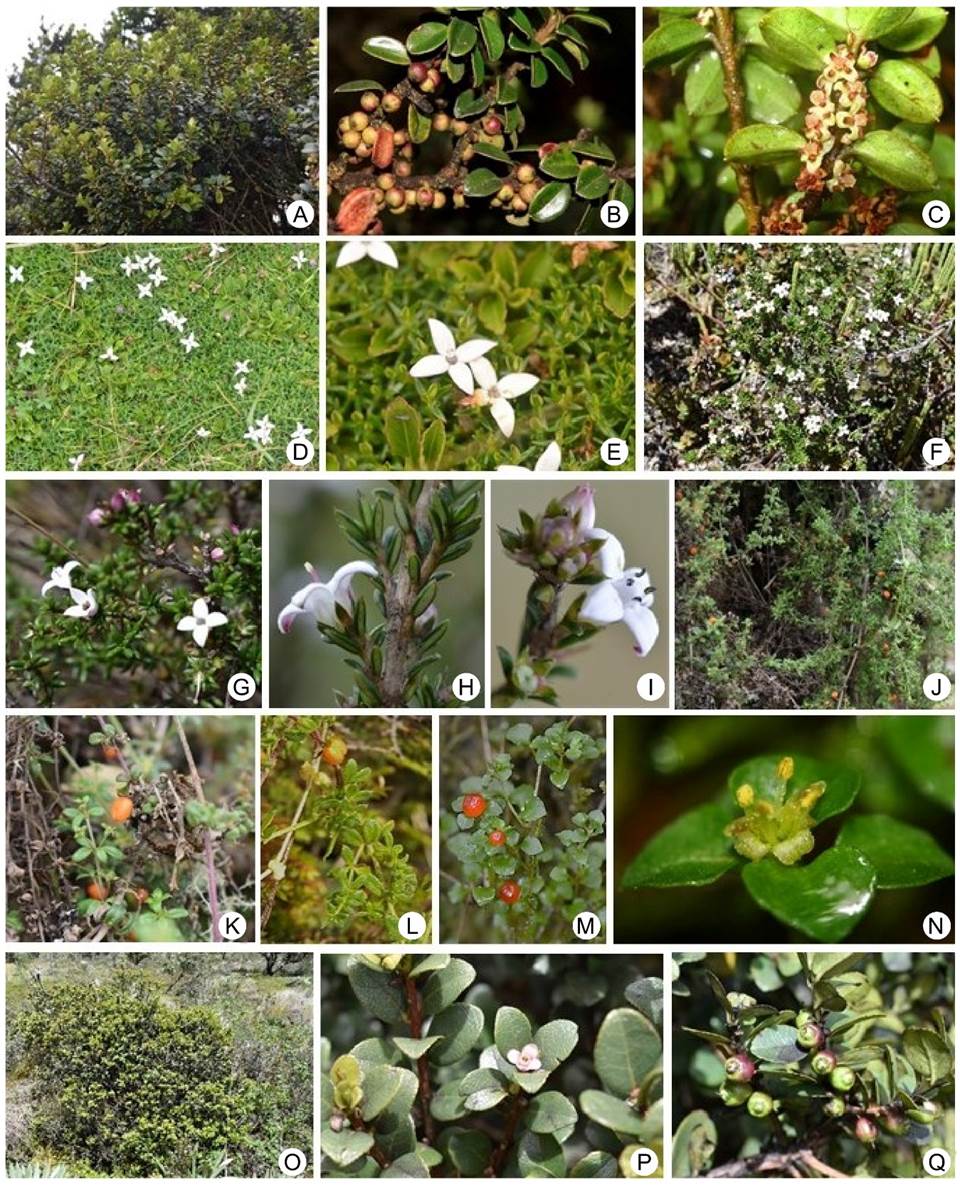Introduction
The high Andean forests are distributed in the Western, Central, and Eastern cordilleras of the Andes in Colombia. The area is located at an altitudinal range of 2400-3500 m a.s.l. (Rangel-Ch. et al., 1997). However, floristic research has occurred mainly in the Western and Central cordilleras (Mosquera-Ramos et al., 2007; León et al., 2009; Idárraga and Callejas, 2011; Alzate et al., 2013; David et al., 2014; Ramírez-Padilla et al., 2015). Existing research in the Eastern cordillera is focused on distributional patterns and dominance of plant communities (Marín and Betancur, 1997; Franco-R. and Betancur, 1999; Galindo et al., 2003; Cortés, 2003; Arias and Barrera, 2007; Fernández-A. and Hernández-S., 2007).
The high Andean forests are characterized by the presence of biogeographically restricted elements that define the physiognomy and composition of the forests (Rangel-Ch. et al., 1997). The forests are very humid and rich in woody and herbaceous plants. Because of these characteristics, species composition is specific at local levels in the Eastern cordillera (Van der Hammen and Cleef, 1983).
The high Andean forests have had the constant influence of farming (especially of potatoes, onions, apples, pears, and peaches), ungulate-grazing (cattle, horses, and pigs), and mining (coal, emeralds, and iron). It also has lost areas to a matrix of grasslands (Pennisetum Rich., Brachiaria (Trin.) Griseb., and Holcus lanatus L.), and this has led to a loss not only of forest biodiversity, but also of connectivity (Armenteras et al., 2003, 2013; Etter et al., 2006; Medina et al., 2015).
The objective of this research is presenting the description of the composition, richness and distribution of species of the high Andean forest of the Bijagual Massif, Boyacá, Colombia. Additionally, we have included data of threatened categories and endemic species.
Materials and Methods
Study area
The Bijagual Massif is located in the department of Boyacá, Colombia, at the coordinates 5°26'10.28"-5°15'40.21"N and 73°13'5.20"-73°21'58.19"W, with an area of extension of 8604 ha (Gil-Leguizamón et al., 2020). Its limits are the Tota lake to the north and the Mamapacha Massif to the south (Tota-Bijagual-Mamapacha complex; Morales et al., 2007). The high Andean forest distribution (2682-3268 m a.s.l.) abuts paramo flora at the highest altitudes (2990-3460 m a.s.l.). Currently, Bijagual is not a protected natural area. There are excessive activities of inappropriate soil use with more than 50% committed to farming and cattle (Fig. 1; Gil, 2016).
Data collection
We established 27 transects in the high Andean forest of Bijagual (100 × 5 m=500 m2) (Rangel-Ch. and Velásquez, 1997). For each individual, the abundance, growth form, height, coverage, diameter at breast height for trees, and basal area for shrubs were noted (data published in Gil-Leguizamón et al., 2020).
For determination of botanical material, specialized literature for families and genera of the woody plants (Gentry, 1993), Flora de Colombia (FDC, 2021), Flora Neotropica (SFNM, 2021), Flora de Costa Rica (BMCR, 2021), and Flora de Panamá (PAC, 2021) were used, as well as the International Plant Name Index (IPNI, 2021) for correct citations of the scientific names; for suprafamiliar classification APG IV (2016) was used. Each specimen was confirmed with the HECASA (Universidad de Pamplona, Colombia) and UPTC (Universidad Pedagógica y Tecnológica de Colombia) herbarium collections, virtual herbarium reviews (COL herbarium; COL, 2021), and web pages (Botanicus, 2021; TPL, 2021; Tropicos, 2021) and with a botanical specialist. Vouchers were deposited in the UPTC herbarium reference collection under Gil-Leguizamón P.A. collection numbers.
Data analysis
This study of vascular plants involved the families and genera with high species richness. For each species, distributional data were obtained in Colombia (of endemic and native species) according to Bernal et al. (2016). We present the table in order to corroborate new records and species identification with their conservation category (IUCN, 2021). The results presented here expand the information of Gil-Leguizamón et al. (2020) about the structure and diversity of the vegetation of the Bijagual Massif paramo complex.
Results
We recorded 327 species, distributed in 151 genera and 69 families (Appendix; Figs. 2, 3, 4, 5, 6, 7, 8, 9 show some of these species). The families with the highest species richness (16 families or 23%) are: Asteraceae, Orchidaceae, Melastomataceae, Ericaceae, Bromeliaceae, Rubiaceae, Poaceae, Rosaceae and Araliaceae. These contained 59% of the genera and 70% of the species (Table). The most diverse genera are (16 or 11%) Miconia Ruiz & Pav., Pentacalia Cass., Epidendrum L., Tillandsia L., Ageratina Spach, Diplostephium Kunth, Stelis Sw., Pleurothallis R. Br., Rubus L., and represent 35% of the total number of species (Table).

Figure 2: Recorded vascular plants in the Bijagual Massif, Boyacá, Colombia. A-C. Viburnum triphyllum Benth.; D, E. Anthurium sp.; F, G. Oreopanax mutisianus (Kunth) Decne. & Planch.; H, I. Diplostephium floribundum (Benth.) Wedd.; J, K. Diplostephium tenuifolium Cuatrec.; L-N. Espeletia boyacensis Cuatrec.

Figure 3: Recorded vascular plants in the Bijagual Massif, Boyacá, Colombia. A-C. Espeletia murilloi Cuatrec.; D-F. Pentacalia pulchella (Kunth) Cuatrec.; G, H. Greigia stenolepis L.B. Sm.; I, J. Puya goudotiana Mez.

Figure 4: Recorded vascular plants in the Bijagual Massif, Boyacá, Colombia. A, B. Tillandsia turneri Baker; C-E. Brunellia propinqua Kunth; F, G. Siphocampylus sp.; H-J. Clusia multiflora Kunth; K-M. Weinmannia fagaroides Kunth.

Figure 5: Recorded vascular plants in the Bijagual Massif, Boyacá, Colombia. A. Weinmannia rollottii Killip; B, C. Weinmannia tomentosa L. f.; D-F. Vallea stipularis L. f.; G, H. Disterigma alaternoides (Kunth) Nied.; I, J. Gaultheria anastomosans (L. f.) Kunth.

Figure 6: Recorded vascular plants in the Bijagual Massif, Boyacá, Colombia. A, B. Gaultheria erecta Vent.; C, D. Macleania rupestris (Kunth) A.C. Sm.; E-G. Pernettya prostrata (Cav.) DC.; H-J. Escallonia myrtilloides L. f.

Figure 7: Recorded vascular plants in the Bijagual Massif, Boyacá, Colombia. A, B. Halenia asclepiadea (Kunth) G. Don; C, D. Symbolanthus calygonus (Ruiz & Pav.) Griseb. ex Gilg; E-G. Gunnera cf. schultesii L.E. Mora; H-J. Gaiadendron punctatum (Ruíz & Pav.) G. Don; K, L. Bucquetia glutinosa (L. f.) DC.; M-O. Miconia cleefii L. Uribe.

Figure 8: Recorded vascular plants in the Bijagual Massif, Boyacá, Colombia. A, B. Miconia stipularis Naudin; C, D. Monochaetum myrtoideum Naudin; E, F. Myrcianthes rhopaloides (Kunth) McVaugh; G, H. Fernandezia lanceolata (L.O. Willams) Garay & Dunst.; I-K. Chusquea tessellata Munro; L, M. Morella parvifolia (Benth.) Parra-Os.

Figure 9: Recorded vascular plants in the Bijagual Massif, Boyacá, Colombia. A-C. Myrsine dependens (Ruiz & Pav.) Spreng.; D, E. Arcythophyllum muticum (Wedd.) Standl.; F-I. Arcythophyllum nitidum (Kunth) Schltdl.; J-L. Galium hypocarpium (L.) Endl. ex Griseb.; M, N. Nertera granadensis (Mutis ex L. f.) Druce; O-Q. Symplocos theiformis (L. f.) Oken.
Table: Most representative families and genera in the Bijagual Massif, Boyacá, Colombia.
| N° | Families | Genera | Species | Genera | Species |
|---|---|---|---|---|---|
| 1 | Asteraceae | 14 | 47 | Miconia Ruiz & Pav. | 15 |
| 2 | Orchidaceae | 13 | 42 | Pentacalia Cass. | 12 |
| 3 | Melastomataceae | 6 | 22 | Epidendrum L. | 10 |
| 4 | Ericaceae | 10 | 21 | Tillandsia L. | 9 |
| 5 | Bromeliaceae | 7 | 19 | Ageratina Spach | 8 |
| 6 | Rubiaceae | 6 | 12 | Diplostephium Kunth | 7 |
| 7 | Poaceae | 6 | 11 | Stelis Sw. | 7 |
| 8 | Rosaceae | 4 | 8 | Pleurothallis R. Br. | 6 |
| 9 | Araliaceae | 3 | 8 | Palicourea Aubl. | 6 |
| 10 | Solanaceae | 5 | 7 | Rubus L. | 5 |
| 11 | Cyperaceae | 4 | 7 | Anthurium Schott | 5 |
| 12 | Piperaceae | 2 | 6 | Oreopanax Decne. & Planch. | 5 |
| 13 | Lauraceae | 4 | 5 | Weinmannia L. | 5 |
| 14 | Primulaceae | 3 | 5 | Disterigma (Klotzsch) Nied. | 5 |
| 15 | Araceae | 1 | 5 | Gaultheria L. | 5 |
| 16 | Cunoniaceae | 1 | 5 | Lepanthes Sw. | 5 |
| Representative families: 16 (23%) | 89 (59%) | 230 (70%) | Representative genera: 16 (11%) | 115 (35%) | |
| Other families: 53 (77%) | 62 (41%) | 97 (30%) | Other genera: 135 (89%) | 212 (65%) | |
| Total families: 69 (100%) | 151 (100%) | 327 (100%) | Total genera: 151 (100%) | 327 (100%) | |
Twenty percent of the families (14 families) are represented by three or four species and 57% (39 families) by one or two. Of the genera, 13% (20 genera) have three or four species, and 76% (117 genera) one or two taxa, respectively (Appendix).
One hundred eighty-seven species (56%) are native to the Andean region, and 51 (15%) are endemic to the Andes from this area. Only 24 (7%) are endemic to the Colombian Eastern cordillera. Passiflora adulterina L. f., and Plutarchia guascensis (Cuatrec.) A.C. Sm. are restricted to the Cundinamarca-Boyacá highlands. The latter two species are also recorded in the departments of Quindío and Santander (Bernal et al., 2016, Appendix). Schefflera bejucosa Cuatrec. (Araliaceae) is a new record for the department of Boyacá. According to the IUCN (2021) records and the Colombian Red Books, 78 species do not have information about their conservation assessment and threat categorization, but 151 taxa are categorized as Not Evaluated (NE) and 89 as Least Concern (LC) (García et al., 2005; Betancur and García, 2006; Hernández and García, 2006; Bernal et al., 2016). Greigia stenolepis L.B. Sm. (Fig. 3: G, H), Hieronyma rufa P. Franco, Puya goudotiana Mez (Fig. 3: I, J) and Tillandsia pallescens Betancur & García Nestor are Near Threatened (NT) (Betancur and García, 2006). Plutarchia guascensis (Cuatrec.) A.C. Sm., Quercus humboldtii Bonpl. and Symplocos venulosa Cuatrec. are classified as Vulnerable (VU) (Cárdenas and Salinas, 2007), and Diplostephium oblongifoliumCuatrec., and Dunalia trianaei Dammer as Endangered (EN).
Discussion
The study area comprised 1.35 ha and overlapped with a minimum unit (0.1 ha) (Gentry, 1982, 1995; Rangel-Ch. and Velásquez, 1997). We determined that the Bijagual flora has great biodiversity potential as a biological corridor. The species richness and composition in Bijagual is higher compared to other localities in the Colombian Eastern cordillera (Avella-M. et al., 2014; Gil, 2016; Carrillo et al., 2017; Gil-Leguizamón et al., 2020).
In 0.1 ha the average estimated species richness is 109 spp. (17 (some of the species are shown here (Figs. 2, 3, 4, 5, 6, 7, 8, 9), so the results suggest that the number of taxa was very high compared to that reported from other high Andean forests. Species richness fluctuates between 43 and 53 species in other forests in the same cordillera (Marín and Betancur, 1997; Galindo et al., 2003; Arias and Barrera, 2007) and between 18 and 69 species for forests in the Central and Western cordilleras (Gentry, 1995; León et al., 2009; Alvear et al., 2010; Bohórquez et al., 2011; Abud-H. and Torres, 2016; Segura-Madrigal et al., 2019).
Our study found that the total floral richness (327 spp.) is greater for Bijagual than that recorded by Carvajal et al. (2014). These authors determined for the same area 275 species in 86 families. This result is influenced by the total assessed area including species with trunk diameters ≤ to 2.5 cm. This criterion extends the richness to 152 species (39%). Characteristics that contribute to the species richness are strongly associated with the flora from the Tota corridor (north) and Mamapacha (south) in the altitudinal and latitudinal gradients. This is possibly a stochastic species distribution with high species replacement between sampling units (Gil-Leguizamón et al., 2020).
The Bijagual high Andean forests have typical floristic elements of rocky formations (Cuatrecasas, 1934; Rangel-Ch., 1995; Arias and Barrera, 2007). Alvear et al. (2010) and Carvajal et al. (2014) recorded the families Asteraceae, Ericaceae, Melastomataceae, Rubiaceae, Cunoniaceae, and Poaceae as main groups that characterize the ecosystem, which is consistent with the data obtained in this study. However, the Bijagual flora is also represented by families such as Orchidaceae, Rosaceae, Solanaceae, Cyperaceae, Bromeliaceae, and Araliaceae. These make up 29% (95 species) of the total assessed area.
Genera such as Miconia, Pentacalia, Epidendrum, Elaphoglossum Schott ex J. Sm., Tillandsia, Ageratina, Diplostephium, Weinmannia L., Stelis, and Hymenophyllum Sm. are representative in Bijagual and they are diverse (Table). These are recorded by Cuatrecasas (1958), Marín and Betancur (1997), Franco-R. and Betancur (1999), Fernández-A. and Hernández-S. (2007), Montenegro and Vargas (2008), Álvaro-Fajardo et al. (2013) and Jadán et al. (2017), for Colombian and Ecuadorian high mountain formations. Likewise, the abovementioned authors included Brunellia Ruiz & Pav. (Figs. 4C-E), Clusia L. (Figs. 4H-J), Drimys J.R. Forst. & G. Forst., Oreopanax Decne. & Planch., Geissanthus Hook. f., Palicourea Aubl., Piper L., Escallonia Mutis ex L. f., Symplocos Jacq. (Figs. 9O-Q), Hesperomeles Lindl., Clethra L., Ilex L., and Ocotea Aubl., which are also recorded with low species richness in this research (Figs. 2, 3, 4, 5, 6, 7, 8, 9).
In the high Andean Eastern cordillera, records of Lauraceae (Ocotea and Persea Mill.) and Melastomataceae (Axinea A. Juss., Tibouchina Aubl., Bucquetia DC., and Miconia) are dominant in the arboreal and shrubby strata and are also registered for Bijagual, with species like Clusia alata Planch. & Triana, C. elliptica Kunth and C. multiflora Kunth (Figs. 4H-J) (Clusiaceae), Weinmannia balbisiana Kunth, W. fagaroides Kunth (Figs. 4K-M), W. reticulata Ruiz & Pav., W. rollottii Killip (Fig. 5A), W. tomentosa L. f. (Figs. 5B, C) (Cunoniaceae), Ternstroemia cf. camelliifolia Linden & Planch. (Pentaphylacaceae), Brunellia cf. comocladifolia Bonpl. and B. propinqua Kunth (Figs. 4C-E) (Brunelliaceae) (Gentry, 2001; Avella-M. et al., 2014).
Between the altitudes of 2900-3000 (-3200) m, the families Ericaceae and Primulaceae (Myrsine L. and Geissanthus), as well as the genera Oreopanax, Weinmannia, Hedyosmum Sw., Viburnum L., Vallea Mutis ex L. f., Clusia, Gaiadendron G. Don, Myrica L., Piper, Hesperomeles, Palicourea, and Muehlenbeckia Meisn. are recorded (Gentry, 2001; Galindo et al., 2003; Olaya-Angarita et al., 2019; and Gil-Leguizamón et al., 2020). Similarly, some genera recorded in high Andean forest include species that are typical of the forest-paramo transitions in Bijagual, such as Gaiadendrum punctatum (Ruíz & Pav.) G. Don. (Figs. 7H-J), Hesperomeles obtusifolia (Pers.) Lindl., Weinmannia fagaroides (Figs. 4K-M) and W. balbisiana.
Species from subparamo and paramo ecosystems were recorded in the high Andean forest due to vertical migration, although they do not belong to the actual forest (Rangel-Ch., 2000). Suitable features for colonization and development are found at lower altitudes (paramo colonization; Van der Hammen, 1998). Special cases are Hypericum lycopodioides Triana & Planch., Arcythophyllum nitidum (Kunth) Schltdl., Puya goudotiana Mez, Paepalanthus columbiensis Ruhland, Espeletia murilloi Cuatrec., and E. boyacensis Cuatrec., which are also documented by Cortés (2003) for the Eastern cordillera and by Alvear et al. (2010) for the Central cordillera in Colombia.











 nueva página del texto (beta)
nueva página del texto (beta)




